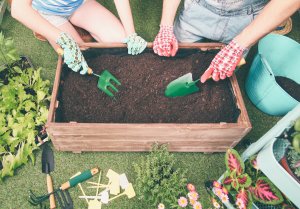

We may earn revenue from the products available on this page and participate in affiliate programs. Learn More ›
It’s not uncommon for beginner gardeners to feel at a loss for where and how to start a garden. Brian Brigantti—aka @RedleafRanch on Instagram, YouTube, and TikTok—started his with no formal knowledge or training, and now has a bountiful harvest time and time again. He’s also the author of Gardening for Abundance, now available on Amazon. We asked him for his top five tips for beginners.
RELATED: Visit our Gardening for Beginners guide
Tip #1: Invite nature in instead of trying to push her out!
When you create an ecosystem in your garden, a beautiful thing happens! Creatures make your garden their home and can become invaluable allies in helping control pests and pollinate your plants! You can create an ecosystem by interplanting native flowers and fruiting plants around the edges of your space or throughout your crops. Just make sure they’re an appropriate size for your space!
Tip #2: Mulch mulch mulch!
One of the greatest things I’ve ever learned in the garden is the value of mulching your garden beds! Mulch is a layer of biodegradable material laid on top of your soil to protect the ecosystem underneath from the harsh rays of the sun and to hold moisture in for longer periods of time! That means less watering and much happier soil. For veggies, I recommend using hay or straw, and for ornamental beds, use wood chips or pine needles.
Tip #3: Don’t forget to feed your plants!
Plants need energy in order to grow and produce fruit. To provide them with that energy, it’s important to supply them with the essential minerals they need in order to thrive. At the start of each garden season, I like to add a fresh layer of compost or worm castings on my beds to give the soil the boost it needs to sustain a new season of plants! Once your plants start to fruit or get a larger size be sure to get on a regular feeding schedule to keep the abundance of nutrients flowing. For example, once my tomatoes start fruiting, I start fertilizing them every 3 to 4 weeks with my homemade organic comfrey fertilizer!
Tip #4: Make your own fertilizer with comfrey!
Speaking of comfrey—comfrey is a miracle plant in the garden. Its long tap root allows it to access nutrients hidden in the deep beneath the soil. It’s a very easy plant to grow and can be introduced effortlessly to the garden by planting tubers. Comfrey is a perennial, so it will be able to provide you with years of abundance. Once the eaves grow to a substantial size, you can harvest them and use them to create a fertilizer tea or you can even bury the leaves within the soil around your plants so it acts as a slow-release fertilizer. The leaves are rich in potassium so they’re perfect boosters for fruiting plants.
Tip #5: Don’t be afraid to prune your plants!
Yellow leaves? Prune. Suckers? Prune. Powdery mildew? Prune! Pruning provides such a wide array of benefits for your plants! If you have drying or yellowing leaves, don’t be afraid to chop them off. Plants are tough and can handle it. Better yet, they’ll appreciate it! Tomatoes can produce tons of suckers, or extra arms growing from the nodules in between stems. These suckers take precious energy from your plant that it can use to produce fruit. Don’t be afraid to snip them off to refocus energy. You can even plop the suckers into a pot of soil and start growing a new plant! If you see powdery mildew on your squash plants, don’t be afraid to chop off those leaves, along with any overlapping ones to help increase airflow throughout your plant. A buildup of moisture leads to mildew and can host an array of other problems. Don’t be afraid to prune!
You can read more about Brian and his garden in our interview. Plus, get to know his top five favorite tools for gardening.
